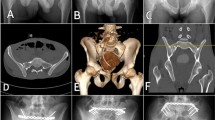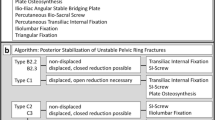Abstract
Purpose
Pelvic ring fractures, occurring in elderly patients are a challenging problem. Little known is about the patient-related outcome after these injuries. The primary objective of this study is to evaluate the quality of life after pelvic ring injuries in patients aged over 60 years.
Methods
Patients (≥ 60 years) with pelvic ring fractures treated in our trauma department between 2004 and 2014 were included. Next to patient data, injury-related details as well as treatment details were assessed. After a follow-up of at least two years, the survival rate and the patient-related outcome were evaluated using the SF-36 and the EQ-5D score.
Results
One hundred ninety-six patients (138 women; 58 men; mean age 75.3 ± 7.8 years) were identified. Ninety-six patients were treated operatively, 100 patients conservatively. The overall complication rate was significantly lower for conservatively compared to operatively treated patients (conservatively 18% vs. operatively 33%; p = 0.014). The total mortality rate over 2 years is 29% with no significant difference of the two-year survival rate (2-year survival rate: operatively 77% vs. non-operatively 65%; p = 0.126). Fifty-five patients completed the SF-36 and EQ-5D score after a mean follow-up of 4.2 ± 2.9 years. The mean physical component score of the SF-36 is 33.6 ± 8.3, and the mean mental component score is 45.3 ± 8.4. The mean EQ-5D VAS reached 62.5 ± 27.9.
Conclusion
Elderly patients with pelvic ring fractures show a high mortality rate and a limited patient-related outcome. While the complication rate of conservatively treated patients is lower compared to operated patients, the two year survival rate is steady.




Similar content being viewed by others
References
Höch A, Özkurtul O, Pieroh P et al (2017) Outcome and 2-year survival rate in elderly patients with lateral compression fractures of the pelvis. Geriatr Orthop Surg Rehabil 8:3–9
Working Group Mortality in Pelvic Fracture Patients, Holstein JH, Culemann U, Pohlemann T (2012) What are predictors of mortality in patients with pelvic fractures? Clin Orthop Relat Res 470:2090–2097
Dodge G, Brison R (2010) Low-impact pelvic fractures in the emergency department. CJEM 12:509–513
Rommens PM, Ossendorf C, Pairon P et al (2015) Clinical pathways for fragility fractures of the pelvic ring: personal experience and review of the literature. J Orthop Sci 20:1–11
Rommens PM, Hofmann A (2013) Comprehensive classification of fragility fractures of the pelvic ring: recommendations for surgical treatment. Injury 44:1733–1744. https://doi.org/10.1016/j.injury.2013.06.023
Bukata SV, DiGiovanni BF, Friedman SM et al (2011) A guide to improving the care of patients with fragility fractures. Geriatr Orthop Surg Rehabil 2:5–37
Peeters CMM, Visser E, Van de Ree CLP et al (2016) Quality of life after hip fracture in the elderly: a systematic literature review. Injury 47:1369–1382. https://doi.org/10.1016/j.injury.2016.04.018
Ekström W, Németh G, Samnegård E et al (2009) Quality of life after a subtrochanteric fracture: a prospective cohort study on 87 elderly patients. Injury 40:371–376
Muhm M, Arend G, Ruffing T, Winkler H (2013) Mortality and quality of life after proximal femur fracture—effect of time until surgery and reasons for delay. Eur J Trauma Emerg Surg 39:267–275
Codesido P, Mejía A, Riego J, Ojeda-Thies C (2017) Subtrochanteric fractures in elderly people treated with intramedullary fixation: quality of life and complications following open reduction and cerclage wiring versus closed reduction. Arch Orthop Trauma Surg 137:1077–1085
Desteli EE, İmren Y, Erdoğan M, Aydagün Ö (2015) Quality of life following treatment of trochanteric fractures with proximal femoral nail versus cementless bipolar hemiarthroplasty in elderly. Clin Invest Med 38:E63–E72
Borg T, Berg P, Fugl-Meyer K, Larsson S (2010) Health-related quality of life and life satisfaction in patients following surgically treated pelvic ring fractures. A prospective observational study with two years follow-up. Injury 41:400–404. https://doi.org/10.1016/j.injury.2009.11.006
Harvey-Kelly KF, Kanakaris NK, Obakponowe O et al (2011) Quality of life and sexual function following traumatic pelvic fracture. Injury Extra 42:125–126. https://doi.org/10.1016/j.injury.2011.06.287
Marsh JL, Slongo TF, Agel J et al (2007) Fracture and dislocation classification compendium - 2007. J Orthop Trauma 21:S1–S6
Bullinger M, Kirchberger I, Ware J (1995) The German SF-36 health survey translation and psychometric testing of a generic instrument for the assessment of health-related quality of life. Journal of Public Health 3:21–36
Brooks R (1996) EuroQol: the current state of play. Health Policy 37:53–72
Ellert U, Kurth BM (2013) Health related quality of life in adults in Germany: results of the German Health Interview and Examination Survey for Adults (DEGS1). Bundesgesundheitsblatt Gesundheitsforschung Gesundheitsschutz 56:643–649
Hinz A, Kohlmann T, Stöbel-Richter Y et al (2013) The quality of life questionnaire EQ-5D-5L: psychometric properties and normative values for the general German population. Qual Life Res 23:443–447
Hinz A, Klaiberg A, Brähler E, König H-H (2006) The Quality of Life Questionnaire EQ-5D: modelling and norm values for the general population. Psychother Psychosom Med Psychol 56:42–48
Mendonça TMDS, Silva CHMD, Canto RS de T et al (2008) Evaluation of the health-related quality of life in elderly patients according to the type of hip fracture: femoral neck or trochanteric. Clinics 63:607–612
Peterson MGE, Allegrante JP, Cornell CN et al (2014) Measuring recovery after a hip fracture using the SF-36 and Cummings scales. Osteoporos Int 13:296–302
Griffin XL, Parsons N, Achten J et al (2015) Recovery of health-related quality of life in a United Kingdom hip fracture population. Bone Joint J 97-B:372–382
Breuil V, Roux CH, Testa J et al (2008) Outcome of osteoporotic pelvic fractures: an underestimated severity. Survey of 60 cases. Joint Bone Spine 75:585–588
van Dijk WA, Poeze M, van Helden SH et al (2010) Ten-year mortality among hospitalised patients with fractures of the pubic rami. Injury 41:411–414
Leung WY, Ban CM, Lam JJ et al (2001) Prognosis of acute pelvic fractures in elderly patients: retrospective study. Hong Kong Med J 7:139–145
Taillandier J, Langue F, Alemanni M, Taillandier-Heriche E (2003) Mortality and functional outcomes of pelvic insufficiency fractures in older patients. Joint Bone Spine 70:287–289
Oliver CW, Twaddle B, Agel J, Routt ML (1996) Outcome after pelvic ring fractures: evaluation using the medical outcomes short form SF-36. Injury 27:635–641
Van den Bosch EW, Van der Kleyn R, Hogervorst M, Van Vugt AB (1999) Functional outcome of internal fixation for pelvic ring fractures. The Journal of Trauma: Injury, Infection, and Critical Care 47:365–371
Author information
Authors and Affiliations
Corresponding author
Ethics declarations
Conflict of interest
The authors declare that they have no conflict of interest.
Ethical approval
All procedures performed in studies involving human participants were in accordance with the ethical standards of the institutional research committee and with the 1964 Helsinki declaration and its later amendments or comparable ethical standards. Additional informed consent was obtained from all individual participants for whom identifying information is included in this article.
Rights and permissions
About this article
Cite this article
Schmitz, P., Lüdeck, S., Baumann, F. et al. Patient-related quality of life after pelvic ring fractures in elderly. International Orthopaedics (SICOT) 43, 261–267 (2019). https://doi.org/10.1007/s00264-018-4030-8
Received:
Accepted:
Published:
Issue Date:
DOI: https://doi.org/10.1007/s00264-018-4030-8




